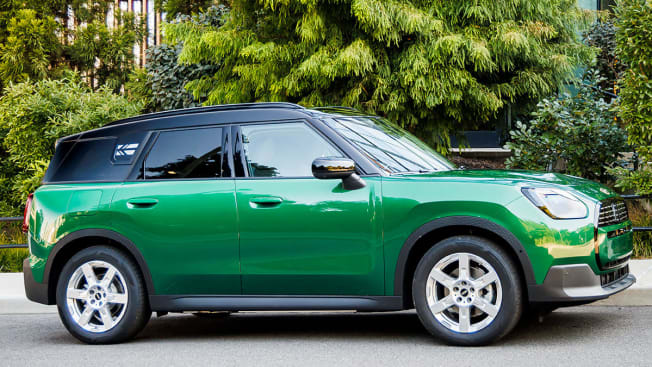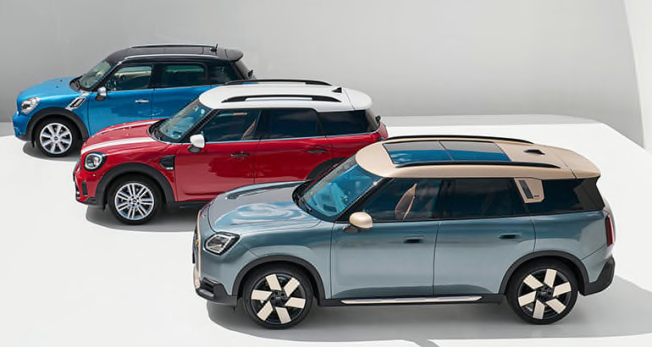Preview: 2025 Mini Countryman SUV Grows in Size, Spawns an Electric Version
This larger SUV will be available in a choice of three powertrains

The Mini Countryman SUV is redesigned for the 2025 model year, growing in size, and based on the 2023 redesigned BMW X1. The biggest news is that there will be a fully electric version with all-wheel drive.
In This Article
CR’s Take • Outside • Inside • What Drives It • Active Safety and Driver Assistance
Mini’s five-passenger SUV keeps its flexible seating, minimalist interior design, and sporty handling (hopefully) while moving forward in the brand’s stated goal of being fully electric by 2030. Also significant, it will finally have blind spot warning.
CR's Take
The Countryman EV is the next step in the brand’s transition to focusing on electric vehicles. No matter what drives it, the Countryman is still recognizable as a Mini, even though some of the brand’s quirks have evolved over time.
In our tests of the outgoing Countryman, we found that the small SUV’s agile handling made it fun to drive. But like the other Minis we’ve tested, it had a firm ride that could become tiresome. The rear seat was supportive, comfortable, and roomy. The added space that the new Countryman promises should make it more competitive with other premium small SUVs.
We expect that blind spot warning (BSW) and rear cross traffic warning (RCTW) will either be standard or optional on the new Countryman. The current model doesn’t even offer these two active safety features.

Photo: Mini Photo: Mini
Outside
One constant with Mini vehicles is that no matter how often they have been redesigned, they’re still immediately identifiable. For 2025, the Countryman has grown roughly 2.3 inches taller and just over 5 inches longer, yet it doesn’t look radically different from its first- and second-generation predecessors, although when positioned next to its siblings, the new SUV’s size and bulk are very apparent.
The Mini “face” remains, with a large, octagonal surround framing the EV’s faux grille and the bumper/area to mount the license plate. Mini continues the tradition of placing the headlights high and to the outside of the Countryman’s nose. This generation gets six-sided LEDs and loses the chrome surrounds.
Continuing the theme, the Countryman sports window glass that seemingly wraps around the entire vehicle, along with the contrasting-color roof.
At the rear, the Countryman’s lights sit vertically at the outer edge of the car, just beyond the tailgate cut line. It appears as if the tailgate has a slightly higher liftover than in the previous-generation Countryman. A chrome skid/damage plate sits below the bumper, offering protection for any mild off-roading.

Photo: Mini Photo: Mini
Inside
You can’t spell “minimalism” without Mini, and with the next-generation Countryman, the automaker is continuing that trend. As with previous models, the 2025 Mini Countryman’s interior is dominated by a large, high-resolution OLED touchscreen that runs the newest Android-based operating system, with a small pod below that houses a collection of toggle switches.
In previous Mini models, a traditional rectangular screen was placed inside a round bezel, which meant it was very short and the edges were cut off by the trim. This new OLED screen is much larger and able to conform to the circular space.
Gone is a traditional instrument cluster for the driver. Now, all information is displayed on the large, round center screen. The top of the screen contains information such as vehicle speed and battery status; pressing the speed display can transform the screen into a full-display speedometer.
Menu functions are displayed on the left and right sides of the screen as small widgets, while the bottom section of the screen houses icons for navigation, media, phone, and climate functions, which are always present and can be chosen at any time.
Below the screen sits the small toggle bar, a Mini design element that reaches all the way back to the original models of the 1960s. In the new Countryman the five toggles control the parking brake, gear selector, start/stop, an optional Experience mode function that changes interior lighting and displays, and volume control. Mini eliminated the traditional gear selector and now uses the space for storage.
Interior materials consist of a new recycled polyester knit that covers the dashboard, upper door panels, and center armrest. Chrome-look materials are used for the air vents, door latches, and cup-holder surrounds, while the seating surfaces are made of synthetic materials.
What Drives It
There are three powertrain configurations for the U.S. market, and all mark significant gains in power, although remember, the SUV itself is larger.
The two-motor electric setup produces a peak of 313 hp. Its 66-kWh battery can be replenished on a public DC fast charger at speeds up to 130 kW, moving its state of charge from 10 percent to 80 percent in 30 minutes, according to BMW/Mini.
The Countryman S ALL4 has a 241-hp, 2.0-liter turbocharged four-cylinder engine with over 100 more horsepower than the 2024 Countryman (134 hp) and over 50 hp more than the S Countryman (189 hp). The transmission is likely to be the seven-speed dual-clutch automatic that serves in the related BMW X1.
The John Cooper Works performance edition goes on sale at the same time, with a 312-hp, 2.0-liter turbocharged four-cylinder engine. (That is an 11 hp increase over the previous generation.) Mini claims this sporty SUV can scoot from 0 to 60 mph in 5.4 seconds.
All three powertrains are coupled with all-wheel drive.

Photo: Mini Photo: Mini
Active Safety and Driver Assistance
Mini hasn’t released information on which active safety systems come standard, though we hope it’s a step up from the current Countryman, which is equipped only with standard automatic emergency braking (AEB) with pedestrian detection. AEB highway, BSW, and RCTW aren’t even offered, but we expect that to change as it did for the latest BMW X1.
The 2025 Countryman’s optional Driving Assistant Plus package includes adaptive cruise control (ACC) and lane-keeping assistance/lane centering.
The Driving Assistant Professional package features give the Countryman the ability to make automatic lane changes and exits from highways, along with hands-free driving at low speeds.





















